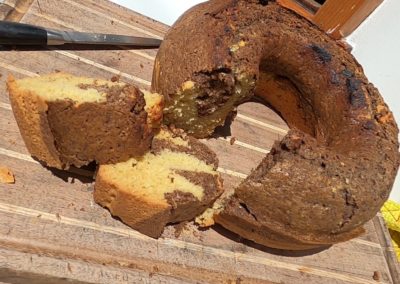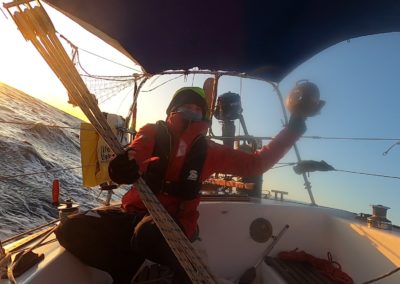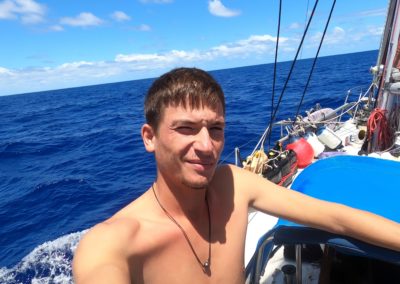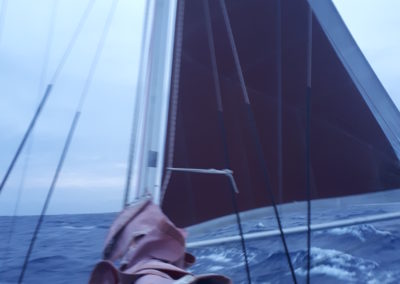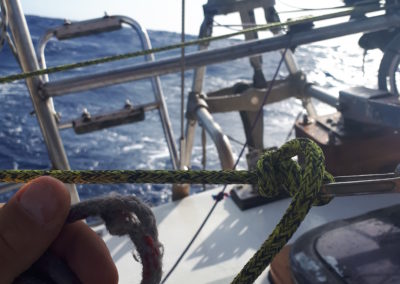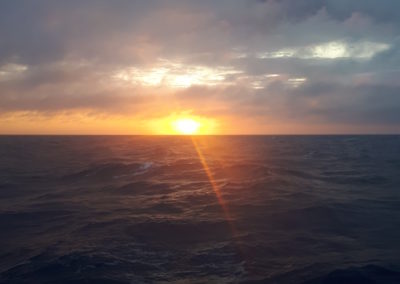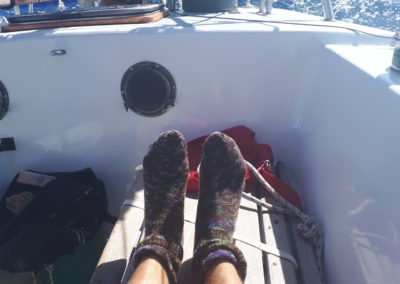
The trip from Fiji to Australia was to be my first serious single-handed crossing. I wanted to know what being alone would do to me. How will it be it, 18 days just me and my boat?
Ahead of me , there have been about 1800 nautical miles with unpredictable weather conditions. I had been watching the weather for weeks: Forecasts for the area around the Australian coast changed daily! New low and high pressure areas constantly appeared, diverted or simply disappeared again completely from the scene.
Since I had signed into an yachtmaster course in Australia next week, (to gain a captain’s license, which allows me to work commercially as a skipper), I had to sail straight, without a further stopover in New Caledonia, to Australia.
I wanted to pass New Caledonia in the south. On the one hand with a safe distance to avoid the reefs reaching far out into the ocean, but on the other hand as close as possible to avoid storms coming from the „roaring forties“ (sea area at about 40°S) up to the north. Then, without losing too much altitude it should go on towards the coast near Brisbane. There I would have turned left to follow the south going current to Sydney.
This plan did not work out 100%: Due to strong headwinds and recurring lulls, I had to turn south much earlier than expected! Shortly before arrival, the weather forced me into a battle against a full sized westerly storm.
But one after the other.
In Fiji I anchored last near Port Denerau in the west of the island Viti Levu. Customs & Immigration were located there and getting into town to replenish provisions was a breeze by public bus.
After clearing out without problems, I treated myself a proper breakfast from my last Fiji – dollars. I drove the dinghy back to WASA, deinflated it and lashed the package neatly onto the deck. At eleven o’clock the anchor came up.
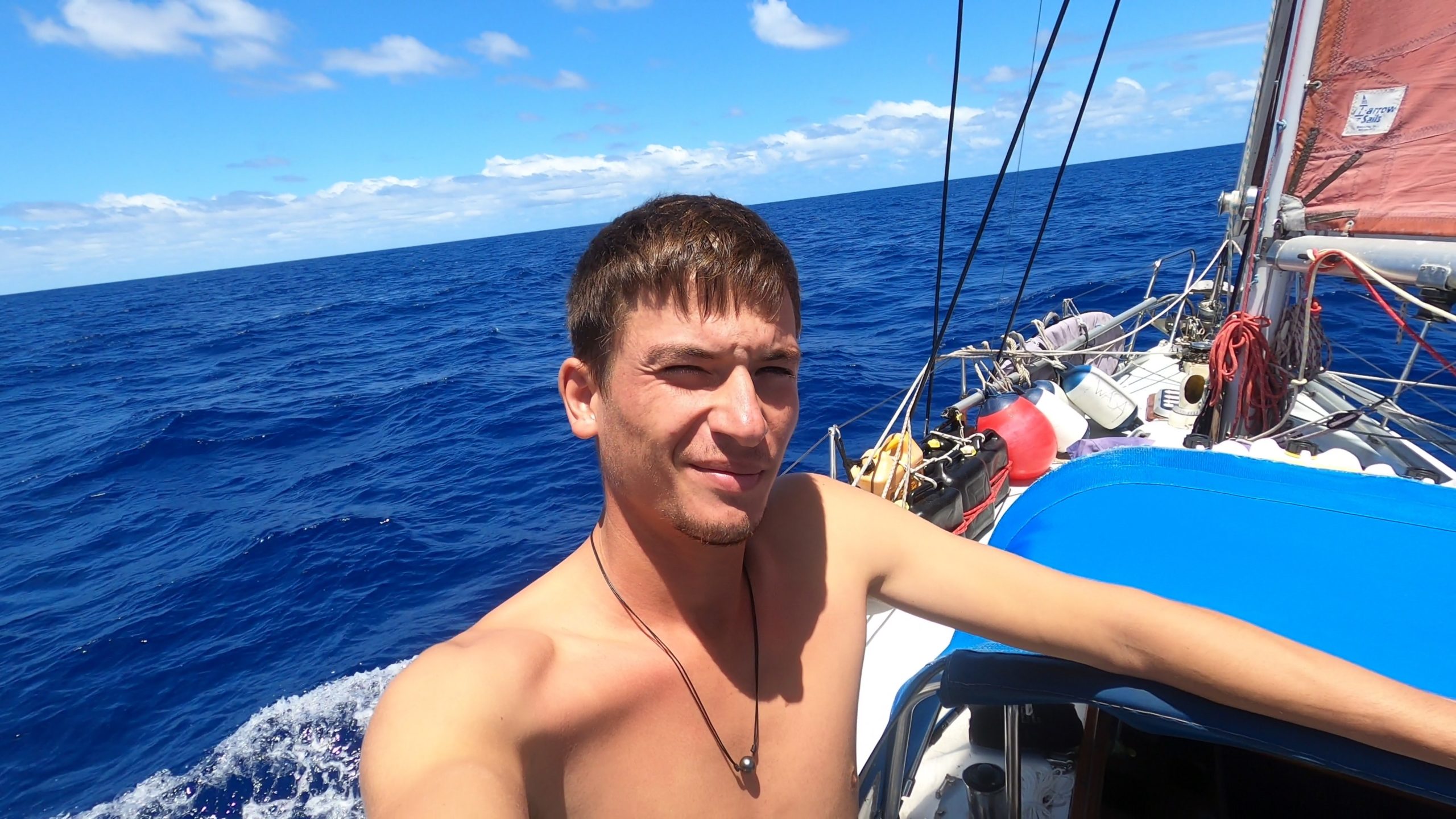

The wind was from the west-southwest and with engine support I cruised towards the pass in the outer reef ring. It turned already late afternoon when Fiji slowly began to vanish in the haze as I had reached the open ocean. The wind remained for a few hours, but than it also vanished completely. – just as the little island.
I furled in the foresail and left only the main remaining to stabilize the boat against the rolling motion of the boat. In the following days I often had absolute lull. The engine ran almost continuously and hammered away. Strong gusts that came out of nowhere kept me busy and robbed me of the last remaining sleep. I started to doubt my plan: „18 days sailing alone?!“. As I was barely making any progress for already three days I started to worry: „Will I make it to Australia in time for my course, or have I just blown a lot of money? „, “ will my supplies last?“.
I had no one to talk to about these thoughts. In the evenings, when I tried to fall asleep, they haunted my mind and kept me awake. Eventually I got to the point where I decided to count everything, but really everything edible on board and calculate how many more days I could sustain myself before running out of supplies. – I had nothing to worry about!
As the wind increased, my self-confidence slowly returned. My dad informed me daily via satellite phone about wind and weather. I was expecting 25 to 30 knots from the southeast and I was really happy about this strong wind warning! „Finally, something is going to moove!“


As the wind continued to increase, I reefed the sails further and further. In the end, the main was gone compleately and only a tiny triangle of the large genoa was still standing; poled out with the spinnaker pole to keep it from flapping back and forth.
Everything kind of stayed the same for five days. While WASA was running between 120 and 140 nauticle miles a day, I spent most of the day inside in the saloon. It was much too cold outside, and waves kept sloshing into the cockpit and soaking everything that had been forgotten there.
I slept well! The wind direction remained relatively constant and the wind vane worked just perfectly! I managed to sleep at night regularly 2 – 3 hours at a time before my alarm clock woke me for the course check. Only once I had to do some work: the control line of the windvane chafed and I had to change it under full speed. Fortunately, after some thoughts were made, this turned out not to be too much of a hussle:
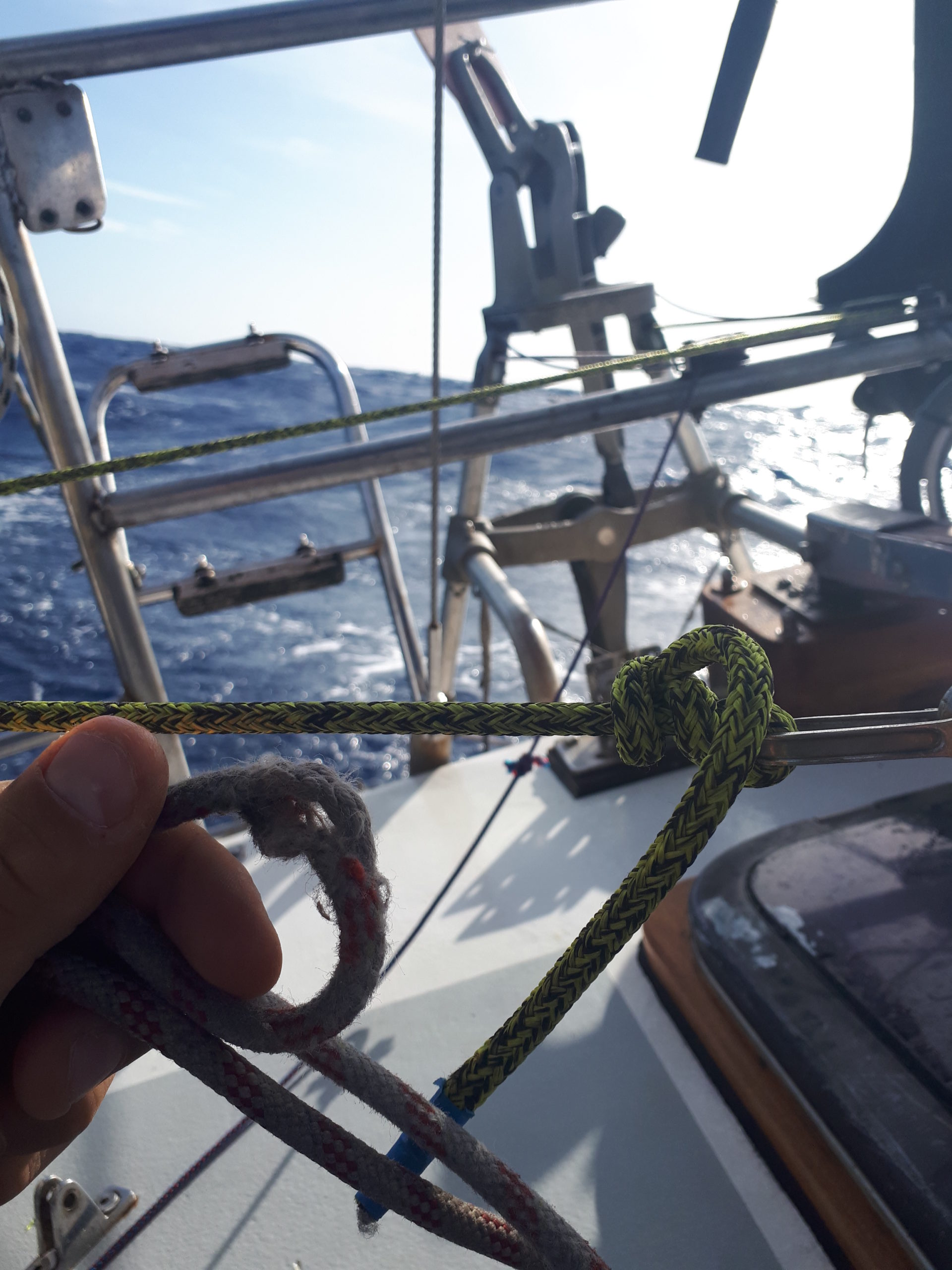

I sewed the old line to the new one. Then I had to climb out of the cockpit to the outside of the stern to cut the old line from the pendulum rudder and to tie on the new one. Then I was able to pull the new line through the old one in one go. Within 5 minutes the Windvane was steering again as if nothing had happened!
On day 10, the wind fell asleep again. In addition, I apparently steered through an area with changing currents. Despite running the engine, I measured a record of slowness during these days: seven nautical miles in more than 10 hours! – It was enough to make one’s hair stand on end.
But this time I didn’t let my inner whiner get the best of me! Instead, I passed the time with baking and needlework! From the last Fiji coconuts I made coconut milk and together with cocoa from Samoa I created an admittedly pretty awesome version of marble cake. I studied for the Yachtmaster and for my ship papers I sewed a new document bag with embroided boat name.


It has been the quiet before the storm. The wind began to freshen more and more and reached a strength of 30 knots on average on the 15th day of my trip. Unfortunately, it did not came from behind from behind, but instead, the wind sometimes blew northwest sometimes from west and sometimes from southwest. To put it simple: always exactly onto the nose!
The constantly varying wind directions made tactical tacking impossible and it became a never ending story about tacking and course correction. The weather was getting colder and colder and I couldn’t get out of my bad weather clothes. I wore thick socks, ski underwear, sweater, rubber boots, rain pants and jacket. A total of three days in a row! In my diary I summarized the last 70 hours to Sydney:
„The last few days have been bad. I was about 130 nautical miles north of Sydney and 70 nautical miles from the coast of Australia when a storm hit, blowing 40 knots and well over 50 knots in gusts. I can’t say how strong the wind actually was – my anemometer gave up at some point and showed nothing at all. It was definitely worse than the storm off French Guiana and everything else.
I had not experienced anything like this before: Water everywhere! The waves crashed over the deck; the spray – ice cold – slammed into my face with such force that it hurt. Part of my sunscreen was torn to shreds and the plastic panes of my sprayhood were crushed by the waves.
On the foredeck, when setting the storm sail or cutting loose my overboard canisters, I suddenly found myself standing knee-deep in water when the boat banged against the waves. I slept; if one can speak of it; wedged between bunk and saloon table on the floor on a sleeping mat and a sail bag.
Every hour an alarm clock rang to check the course and to keep a lookout for freighters. On average, I radioed three freighters every night to make sure we wouldn’t get too close in that weather. I could not run away from the storm. – It would have blown me far out to sea again and would have turned all the work of the previous days to nothing.
Instead, I had to sail against the wind as best I could. I was relieved when after 20 hours the wind slowly decreased again. The 20-30 knots that my anemometer then showed again seemed to me almost like calm.
In the morning at four o’clock (on 03.11.22) I sailed my last tack and then set a direct course for Sydney.“



Under sail I came into the entrance of Sydney Harbour. Only when I arrived in the narrow fairway leading upwind, I droped main and jib and covered the last two miles to the customs dock under engine.
Looking for a suitable place for the night, I suddenly faced an unexpected challenge: The many marinas marked on the map were almost all private and had no guest moorings. After a while of unsuccessful searching, I finally decided to dock at a boat refueling station and ask the attendant for help.
This man became my hero of the day! After I described my situation, Anthony took me to his office, made hot coffee, opened a package of cookies, and scoured the Internet with me for possible moorings. He gave me his cell phone to make a call and asked his friends at the pier for tips. In the end, we didn’t find a suitable marina – the cheapest offer for one night was $80. But we did find a free anchorage just 5 minutes away!
In Blackwattle Bay; maybe 800 meters away from the Operahouse; I anchor since then. I may stay for 28 days, need only a few paddle strokes with the dinghy ashore and am only a short walk from the city center! Actually, it could not have gone better!
FIJI:
Whoever has recently tried to read new articles on my blog has probably not found very much. This is honestly only because it was much too beautiful in Fiji, as that I could find enough motivation to sit down at the desk and write articles. But I definitely want to make up for that.

